I’ve been going to GenCon for a long time now, and I love the chance to run games, try out new RPGs and board games, and catch up with friends I only get to see once a year. Last year was the first time I had allowed “work” to intrude on my busy vacation/entertainment schedule by doing stuff for Goonhammer, namely by taking the opportunity to interview Mike Tunez from Firelock Games (which I did again this year, look for that article soon). This year that trend continued and it was the first time I actually worked a booth in the dealer hall (I write freelance for Columbia Games when I’m not peddling historicals for GH). And when GH needed someone to cover the Asmodee first look event the Wednesday evening before the con, I put on my “press” hat and dove in!
For the record, this was kind of a surreal thing for me. Back when I first joined the fledgling Goonhammer in 2020, we were just a bunch of idiot nerds writing about games we liked. That is still very much what we are, but somewhere along the line I blinked and now we’ve apparently become, like, some kind of marginally respectable gaming news outlet? Invited to press events? Hob-nobbing with other luminaries in game journalism (at this event I bumped into Matt Lees of Shut Up & Sit Down fame – literally, I backed right into the guy. Sorry, Matt!) and getting to look at what Asmodee has both on offer now and coming in the near future? Crazy talk!
The panoply of games on offer was truly staggering, but here are some of the highlights!
Monkey Palace
Prior to the event, Asmodee rep Ashley Pinney sent out a bunch of helpful information about what was going to be on display so that folks could prioritize, and the thing that first caught my eye was Monkey Palace. And it caught my eye because it’s a LEGO game!

Game designer Jonas Resting-Jeppesen was on hand to demonstrate how it works. At its core it is a tableau game, with each player using cards that each yield different build options. Though the game only uses two different kinds of pieces – 1×1 stud blocks and 1×4 stud arches – having more options gives players more flexibility in where and how they can build. This is important, because each player is sequentially adding to the structure, trying on each successive turn to build a set of “stair steps” higher and higher to score more points. But the board (a standard LEGO base plate with a “cover” piece that limits starting locations) has multiple colors on it, so the point from which the path starts matters. This gives the game a surprising amount of strategic depth for such a simple core concept.
Though they were unveiling Monkey Palace at GenCon, it is currently slated for release at the Essen Game Fair. A price point of roughly $40 retail is impressively reasonable, especially considering how expensive LEGO can be (I get a sharp, reflexive pain in my wallet every time my son says, “Dad, I found a new LEGO set that looks really cool!”).
Why I’m excited about this game: It’s LEGO! I am a huge LEGO nerd, and I have kids who are also huge LEGO nerds. To have a game that has interesting game play and lets us be creative is a fantastic combination. I definitely think that this is one we’ll be picking up, and I think the hardest part will be preventing my kids from pilfering the pieces for their own creations!
Forest Shuffle
In Forest Shuffle game, each player builds their “forest” using different varieties of tree, each of which provides different capabilities and provides habitat for different kinds of woodland creatures. The game uses a really interesting mechanic where each card has two different play options (either right/left or top/bottom), giving you choices for how you build out your biome. The “shuffle” part comes from the fact that anything that you discard goes into the face-up “forest” pile, where other players can pick it up themselves. This is fun thematically, because in nature everything eventually gets recycled and nothing goes to waste.
The game also has an interesting mechanism that adds uncertainty to the game’s end condition. When the last of three “winter is coming” cards is drawn, the game is over. This adds a lot of time pressure to the end-game and gives a certain “push your luck” aspect that I love in both boardgames and wargames.
And let’s take a moment to talk about the art. Put simply, it’s stunning. In play, this game is beautiful, as the art is really evocative. In some ways it reminds me of Wingspan, which is another game where the art was the first thing that grabbed me. Alas, for all that I am raving about the art, I completely forgot to take a picture of it at the event! I have it at home now, but my lighting sucks and I have a hard time taking photos of stuff on my kitchen table that will do it justice, so you’ll have to take my word for it.
Forest Shuffle isn’t a new game, but its new Alpine expansion is. The expansion offers 36 additional cards for the very reasonable price of $10. The Alpine expansion adds a bunch of new creatures, many of which are birds. The mountain-themed art is of a style that matches the original game beautifully and really evokes an alpine flavor.
I also want to give a shout out to the design and art team for this game for their “con-exclusive” card. Apparently, licensing the GenCon logo is pretty expensive, and while lots of game companies do it, the Forest Shuffle designers went with a more subtle option. Their con-exclusive card has two creature options, the American Cardinal and the Say’s Firefly, which are the official bird and insect respectively of the convention’s home state of Indiana. Kudos to the team for coming up with something that is both special and subtle!
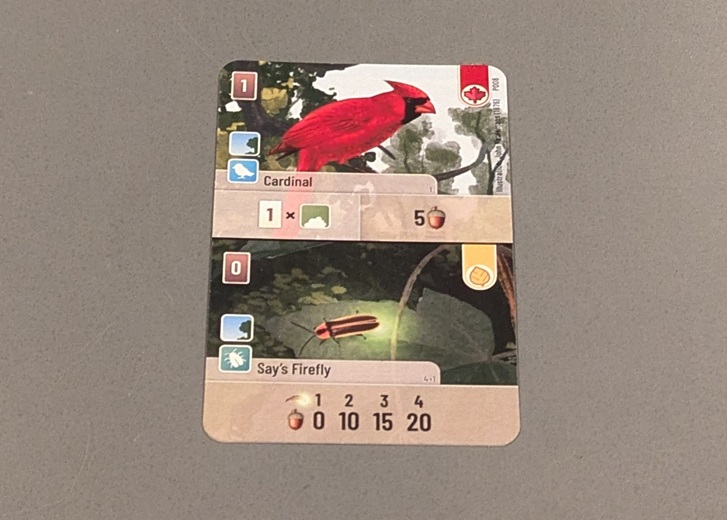
Why I’m excited about this game: It’s pretty. No bones about it, it’s just a really aesthetically pleasing game, with nuanced and interesting game play. I decided at the event that I would be buying this one. Sadly, I once again learned the perpetual lesson of GenCon – buy the stuff you want on the first day! – because by the time I got some free time to hit up the Asmodee booth to buy stuff on Saturday afternoon, both the base game and the Alpine expansion were sold out. Fortunately, I was able to pick up the base game at my FLGS after the con and have the expansion on order.
The Arkham Horror Card Game
Another returning game, this is a lighter weight version of the venerable Arkham Horror board game, which is massive and by this point has many expansions. The card-based version is more focused, and big thanks to Duke, who was on-hand to explain the differences to me.
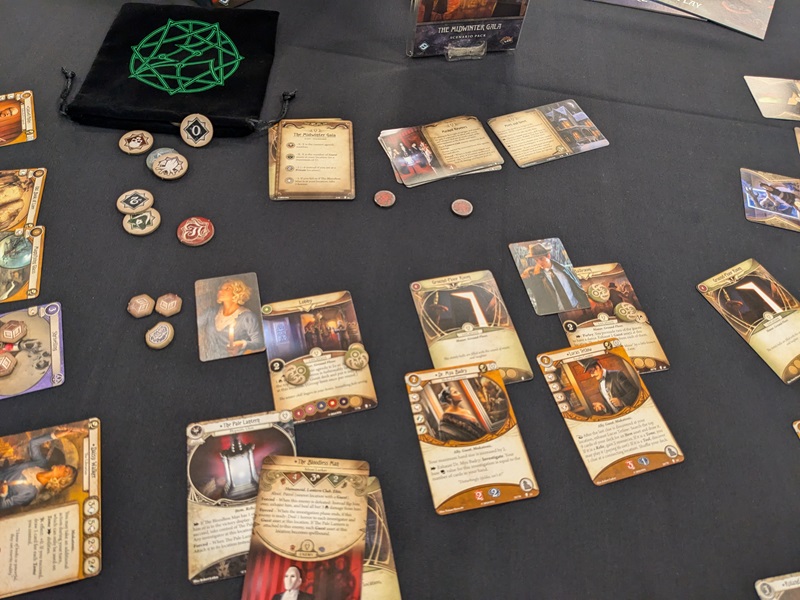
Okay, confession time: though my friends and I do occasionally crack out Twilight Imperium 4 and play for like nine hours at a time, my appetite for really big, complex, crunchy boardgames has waned. Maybe it’s because I’m “an old” now and have a deeper sense of my own mortality, maybe it’s that I have kids and am just too exhausted to be able to muster up the attention span. Whatever, big games are hard.
But the Arkham Horror card game has a much smaller footprint, both in terms of table space and headspace. The mission packs and objectives of each scenario are clear, the cards have the rules for each character, location, or item printed right on them, and it doesn’t feel overwhelming in a way that the full-up board game version can.
Why I’m excited about this game: For all that H.P. Lovecraft is problematic in the modern era, I do loves me some mythos-themed stuff. This is a classic case of having to separate the art from the artist, and with other authors like Derleth and Chambers taking the mythos and running with it, I find games set in that universe oddly compelling. The card game also has some really intriguing mechanics that I don’t recall ever seeing before. Chief among these is a system of symbols that indicates the connections between location cards, which both allows for exploration scenarios and prevents the need for having a fixed “map” on the table. See above under “smaller footprint.” I think there’s a lot to like here, especially if Cthulhu is your thing.
Survive the Island!
Okay, y’all, this one takes me back. This is a re-print of the classic “Survive!” game that I have been playing since I was a kid. It’s a staple at the semi-regular board game weekends that my group of friends puts on, and is always a crowd pleaser.
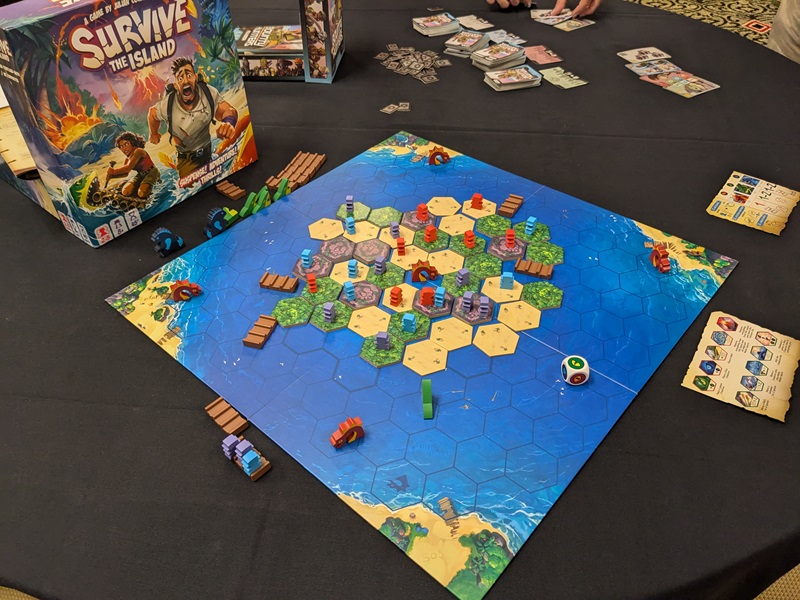
If you haven’t played it before, the central theme is that your island is suffering a volcanic catastrophe and you are trying to get all of your people to safety. Simultaneously, you’re trying to make sure your opponents don’t. Each turn you pick a hexagonal tile to “sink” into the ocean – first the sandy areas, then the forests, then finally the mountains. Each hex has something on the back of it that can either help you (like move a raft, or have a friendly dolphin save a swimmer) or hurt you (like spawning a sea monster!). You can move some of your little survivor meeples – either individually, which is slow, or in a raft where you can move multiple people at once – to safety. Then you can mess with your opponents my moving sea creatures around to either inconvenience them or even just straight up gobble them whole. It’s quick, it’s easy, and it’s hilarious.
Why I’m excited about this game: Nostalgia, y’all. It’s a hell of a drug. This is a game that I can (and have) played with my kids, and nothing is as satisfying as having your daughter overturn your raft full of survivors with a whale, then gleefully pick them off one-by-one with sharks. Good times!
Further, this re-released version retails for $30, down from $35 that the previous release sold for. It’s not often you see stuff get less expensive over time, especially in the current economic environment. The new version has all wood meeple components, which makes it both look and feel great. Oh, and did I mention that it expands the game from four players to five? It released a week before GenCon, and we bought two copies at the con itself – one for ourselves and another as a gift to a friend for whom this is a long-time favorite – happy birthday, Kelly!
Star Wars Bounty Hunters
While this game has already been released, it’s still relatively new. It is a card drafting game of a similar style to games like 7 Wonders, where each player is picking their card simultaneously, then passing their remaining hand on to the next player. I love games like this because they play fast regardless of the number of people at the table (and Bounty Hunters plays up to six).
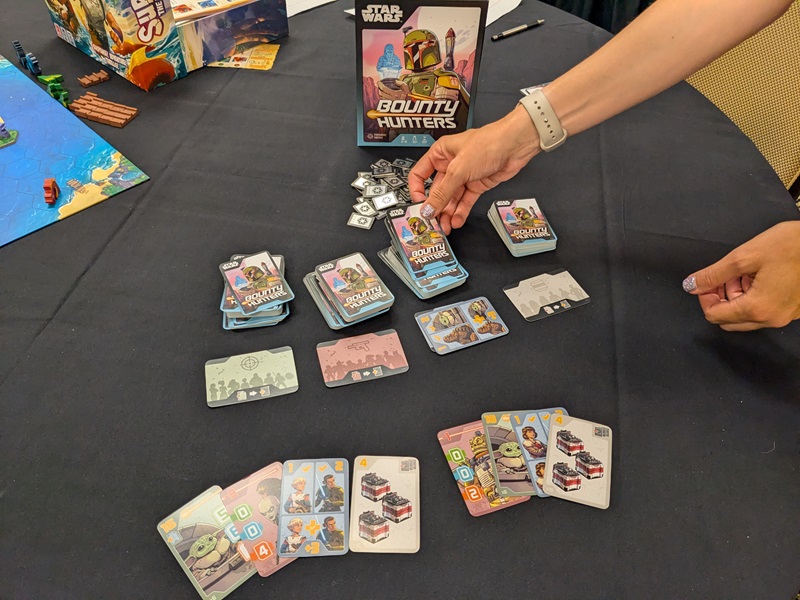
Star Wars Bounty Hunters has the added complication that each turn players will draw a face-down card, play a card, and pass the rest. That means the hand size is constant and there is always tension between the known quality of the cards in-hand, the unknown quality of a blind draw, and the dread of passing your opponent something you know they want. Do you play a sub-optimal card to more viciously screw your opponent? If you play like me, then yeah, yeah you do!
There’s a surprising amount of strategy at play here as well. Target cards give you points, and higher value targets give you more victory points. But higher value targets have bigger defensive numbers associated with them, and you need to exceed those numbers with some combination of hunter cards you’ve played. And of course hunter cards cost you victory points, so there’s that perennial trade-off of whether you go for a few high-value targets or more numerous low-value targets. Decisions, decisions!
Why I’m excited about this game: Only $24.99 for a Star Wars-licensed game is pretty rad. With roughly 250 cards and 42 imperial credit tokens, the game’s components are clean, eye-catching, and have a consistent, cartoonish art style that any fan of the Star Wars cartoons will love.
Pergola
Pergola is a game about building yourself a beautiful garden. Of all the games on offer at the event, this one was probably the prettiest (although Forest Shuffle is right up there). The art style is delightful and there’s something just fresh and wholesome about this game. Each player’s base garden board has different art, and while they all play the same this is another little artistic flourish that I appreciate.
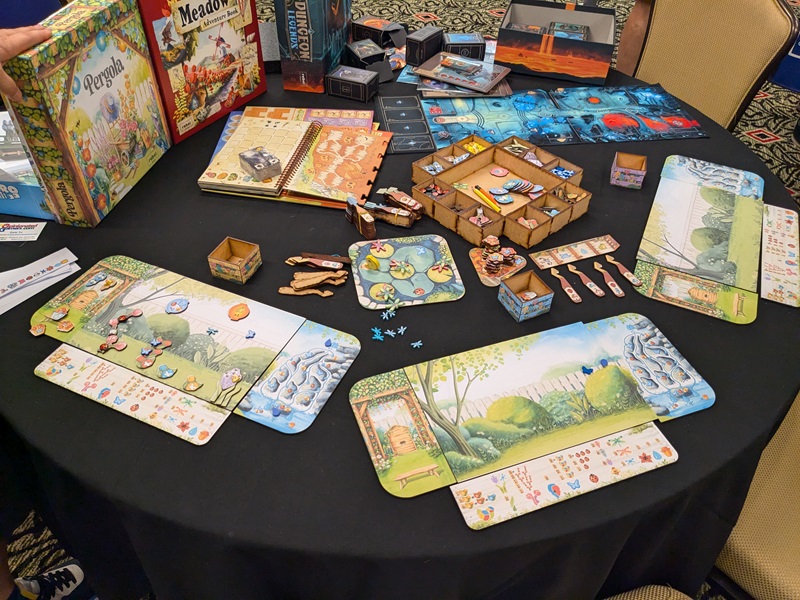
Mechanically, game designer Mikhail (and gosh I hope I spelled that right, he’s from Poland I think) explained how the game works, with players using various tools to add components to their gardens. Different kinds of plants attract different kinds of beetles or butterflies (which give points) and there’s an adorable little pond section of each garden that adds water features to your tableau.
Like any game that offers player choice and flexibility, there are loads of different strategies that players can pursue. Do you go heavy on your water feature? Do you load your garden up with multiples of the same kind of plant, or do you favor diversity? And how does your strategy change when you have to compete with other players for tools and resources?
Pergola is still in the works, with the designers working out the final art and manufacturing details of the game’s components. Though no firm date has been set, the game will probably release in early 2025.
Why I’m excited about this game: This one is easy – it’s GORGEOUS!
Star Wars: The Mandalorian Adventures
OK, so a while back one of my gaming buddies introduced me to a co-op game of daring WW2 commando raids called V-Sabotage. In that game, players take on the roles of Allied commando types – a British sapper, a Russian sniper, etcetera – to wreck face on a bunch of Nazis. You try to be stealthy, but eventually things are going to go badly and the opposition is going to escalate. It’s good clean fun.
Mandalorian Adventures is that, only placed in the setting of Season 1 of popular Star Wars TV series The Mandalorian. Players take on roles such as the titular Mandalorian, or a murderous (but honorable) assassin droid, or other ne’er-do-wells who find common purpose to stick it to the remnants of the Empire.
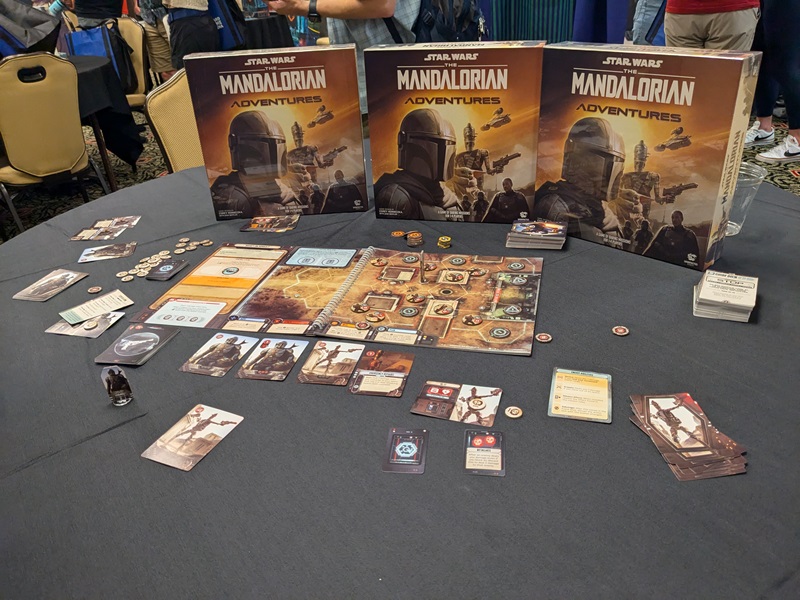
Like most of these kinds of games, the activation mechanics force the players to make hard choices, with the activations that offer players the most chances to drive on the objective also causing “crisis” points to be generated, which give the opposition more chances to throw a wrench in your carefully-laid plans.
The “board” is a large, spiral-bound book that has a number of different maps in it. There are a host of different mission scenarios, and while collectively they outline an entire story arc, each scenario is a stand-alone game (i.e. there’s no resource or experience tracking from session to session). This is done to facilitate just picking the game up and playing it, and you should be able to crack out a scenario in 45 minutes or so (or less if you are as disastrously bad at these games as I am!). There are multiple difficulty settings for each scenario, so you can play the same one multiple times.
And lest you think there’s not enough replayability, there’s a big envelope in the game marked “DO NOT OPEN” that contain “advanced” versions of the scenarios. These have placards that go over the scenario objective sections of each map and introduce new objectives, conditions, and special rules. Or at least that’s what Cory, one of the game designers, told me – it was sealed and I am an inveterate rule-follower so I did not break the seal on the DO NOT OPEN envelope. But I was tempted!
Nerdy side note – in addition to the regular text, a bunch of the text of the game’s components have accompanying text in Aurebesh, the common script in the Star Wars fictional universe. I’m such a goober that I actually decoded the “DO NOT OPEN” in Aurebesh before I read it in English. This is a little immersive detail that Star Wars fans will love.
Additionally, the game has a “traitor” mode, where one (or more!) players are secretly in the employ of the baddies and trying to foil the objectives. But for those who don’t want to play the baddies, the player of the actual Mandalorian character is always loyal. That’s a great way to give people the choice to spice things up while still catering to players who just want to play big damn heroes, which I like.
Why I’m excited about this game: I really like co-op games, and they are popular among my regular gaming group. And of the various Star Wars series, The Mandalorian is essentially a space western, a genre near and dear to my heart. The component quality is top-notch and I think with the popularity of The Mandalorian as a pop-culture franchise, this could be a great “gateway” boardgame for new players.
Lord of the Rings: Duel for Middle Earth
This was another game that I was really excited about, and seeing it in person I was not disappointed! Duel for Middle Earth is a kind of a re-skin of the popular 7 Wonders: Duel, a two-player version of the award-winning 7 Wonders.
I’m going to go on record and say that 7 Wonders is probably my favorite boardgame of all time. Still. And while it is necessarily different, I really like Duel as well. I recently taught my kids to play it, and in her first game my daughter completely thrashed me. Like, it wasn’t even close. Hell, yeah!
Duel for Middle Earth is that, only even better because it’s designed for Tolkien-nerds (and I definitely put myself squarely in the “target market” audience there). The core game play is very similar – players take turns drawing cards from a sort of pyramid, where every card you draw gives you some useful resource but exposes a new resource to your opponent.
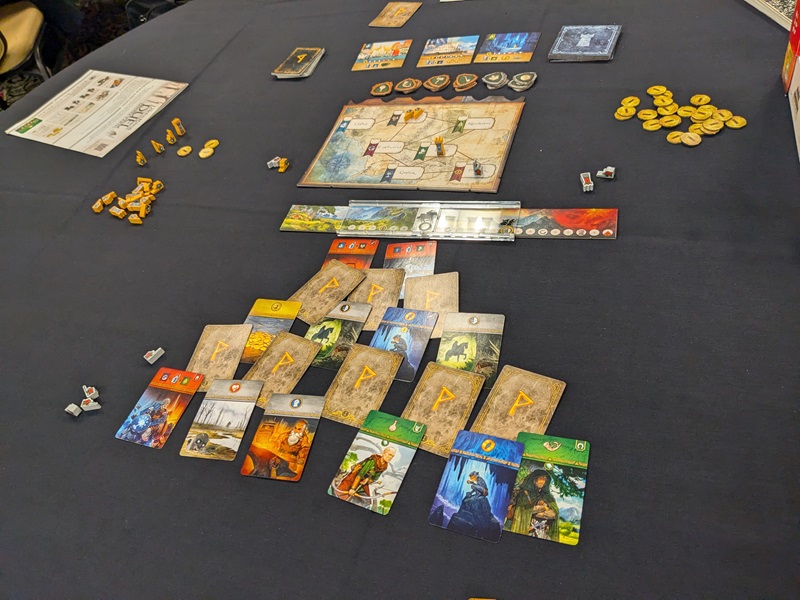
In addition to the sort of area-control mechanics (similar to the way you gain science victories in 7 Wonders: Duel), the game has this fantastic little track that works kind of like military victories in 7W:D. Only instead of it being opposed, it’s a race! The game component here is awesome, comprised of two clear bits over a strip with an evocative rendering of the terrain along the path to Mordor. The player of the fellowship moves the whole thing towards Mt. Doom, and if they reach the end they toss the One Ring into the volcano and score a sudden-death win. But the player representing Sauron is moving the Nazgul piece in hot pursuit, and if the Nazgul ever catch the hobbits, it’s an instant win for the forces of darkness. I absolutely adore this bit, both as an adaptation of the progenitor game and as a well-designed game component.
While it was available for demo at GenCon, Lord of the Rings: Duel for Middle Earth is slated for release at Essen. According to Asmodee rep Luke Peterschmidt, who was kind enough to answer all my questions and forgive my Tolkien-fanboy drool, it will likely retail somewhere around $25.
Why I’m excited about this game: Did I mention that I’m a Tolkien fanboy? I really like the parent game, and I feel like this one changes just enough of the core game mechanics to make it worth playing as a way to change things up. And I really hope that this one gets expansions similar to what’s been done for Duel with Pantheon and Forum, both of which are cool and change the base game in interesting ways.
Post-Event Round-Up
This event was fantastic for getting an early look at new and upcoming games, and it was a great way to spend an evening before the convention’s official start. And even spending the event’s entire allotted time there, I didn’t get to check out everything because there was an overwhelming amount of stuff to see. But I really appreciated the opportunity to talk to people representing their games. With designers especially you can see their passion come through, and that’s one of my favorite parts about seeing and trying new things at GenCon – the folks there love games just as much as I do!

Big thanks to Asmodee reps Ashley and Michaela for answering all my questions, putting on the event, and making everything run smoothly. My dietary resolve did eventually break down and I grabbed one of the big ol’ cookies that had been tempting me the whole event from a side table. Oh, man, they were delicious! But I probably shouldn’t talk too much about the cookies lest there be fierce competition among my fellow Goonhammer contributors for a spot at this event next year!
Have any questions or feedback? Drop us a note in the comments below or email us at contact@goonhammer.com. Want articles like this linked in your inbox every Monday morning? Sign up for our newsletter. And don’t forget that you can support us on Patreon for backer rewards like early video content, Administratum access, an ad-free experience on our website and more.


